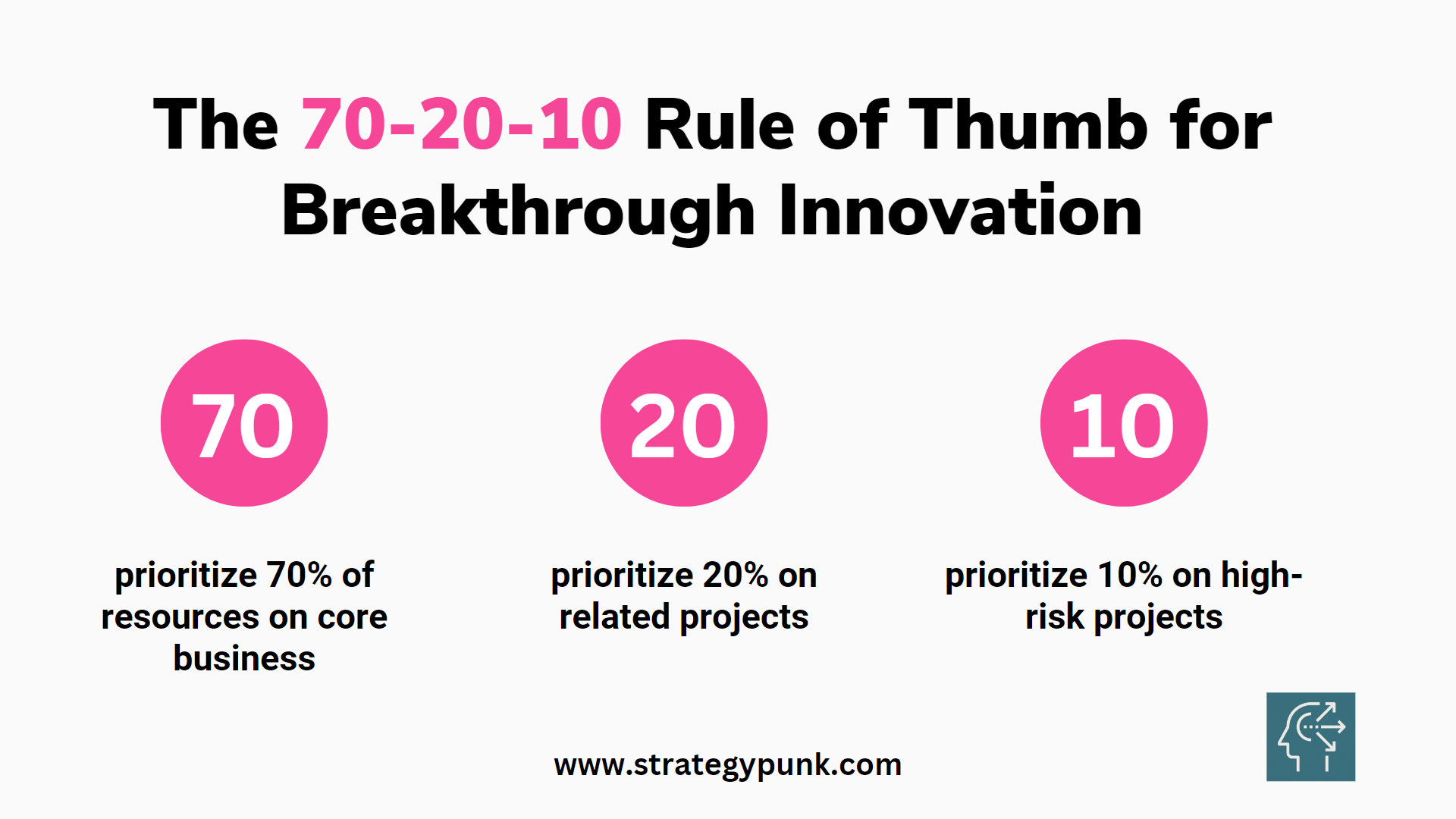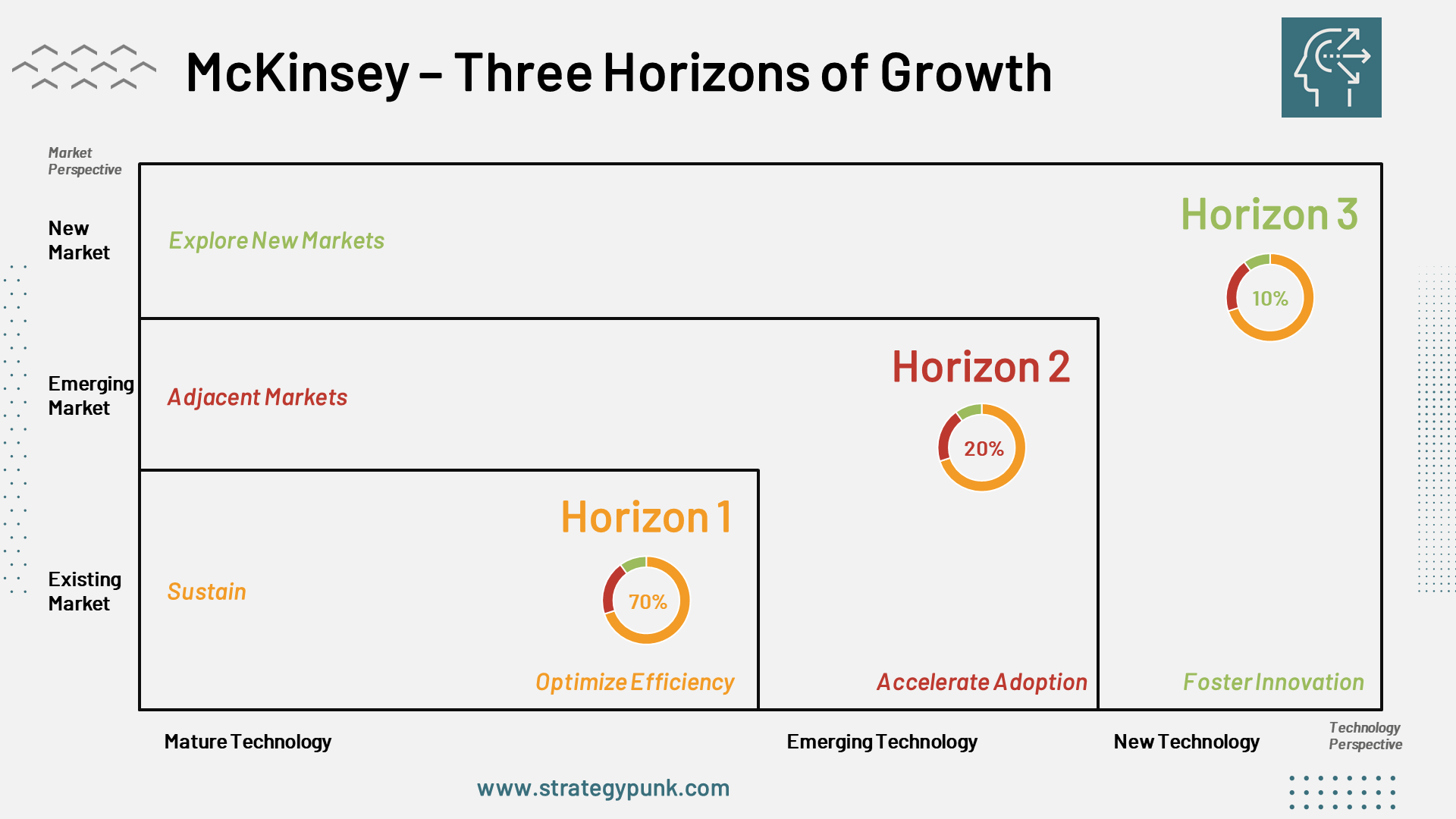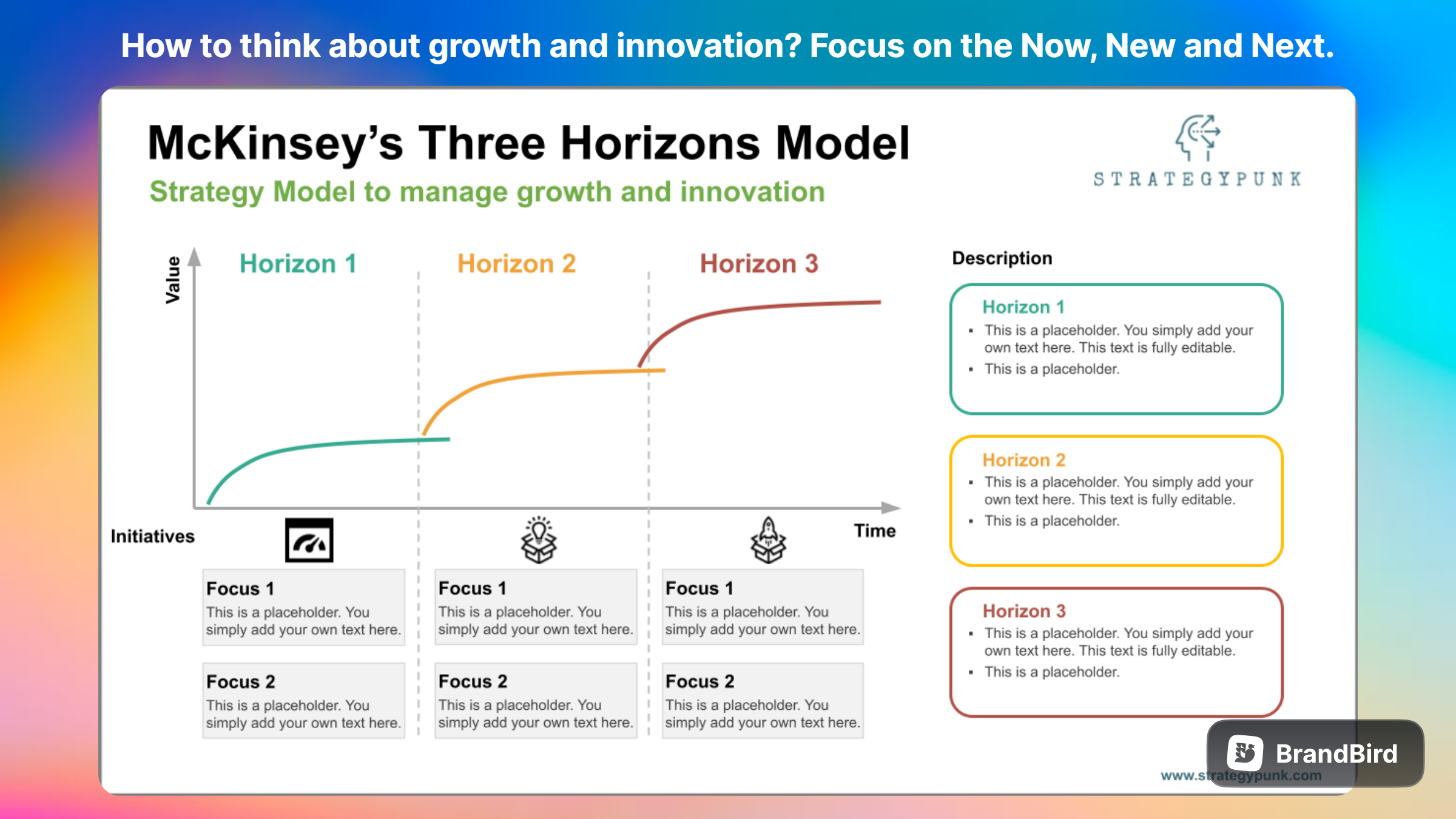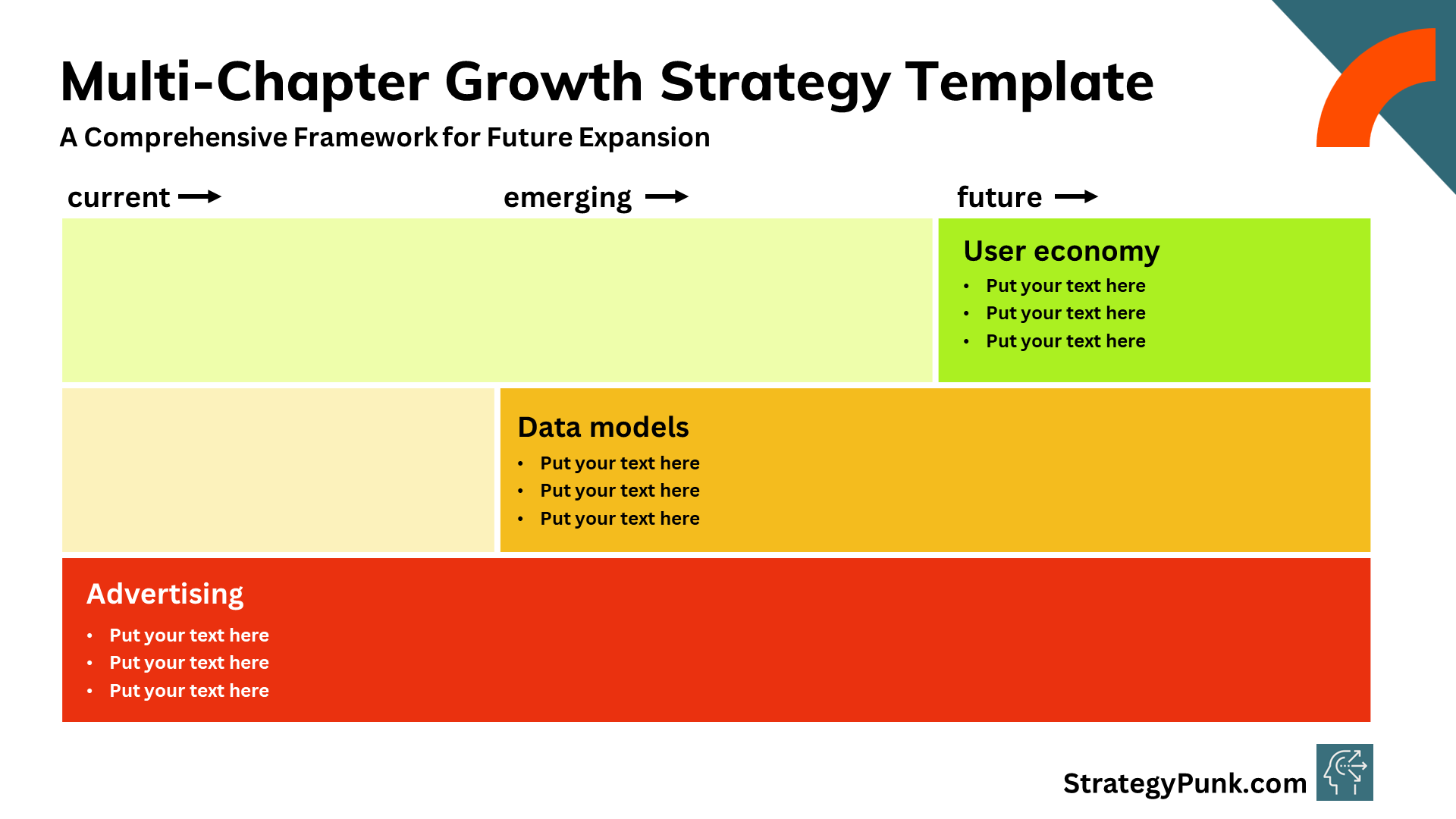Embrace the 70-20-10 Rule of Thumb for Breakthrough Innovation
Master the 70-20-10 Rule of Thumb for Innovation. Discover the key to a thriving, future-proof business in our insightful guide.

Introduction
The 70-20-10 rule is a widely accepted concept in the business world. It suggests that companies allocate their resources and human capital in a specific ratio to promote innovation and growth. The rule states that 70% of the company's investment should go to the core business, 20% to new developments, and 10% to new and untested ideas.
This rule of thumb has been applied in various fields, including leadership development, innovation portfolios, and career development. By following this ratio, companies can balance their focus between maintaining their current business and investing in future growth opportunities. By dedicating resources to new initiatives, companies can remain competitive and adapt to changing market conditions.
This article will explore the 70-20-10 rule in detail, examining how it can foster business innovation and growth.
We will also discuss how companies can use this rule to manage their innovation portfolios effectively and achieve long-term success.
Understanding the 70-20-10 Rule of Thumb

What is the 70-20-10 Rule of Thumb for Innovation?
The 70-20-10 Rule of Thumb is a model for allocating resources and human capital between different innovation projects. Morgan McCall, Robert W. Eichinger, and Michael M. Lombardo from the Center for Creative Leadership introduced the rule in the 1990s. The rule suggests that companies should invest 70% of their resources and human capital in the core business, 20% in new developments, and 10% in new ideas that might initially seem crazy.
Why is the 70-20-10 Rule of Thumb important for Innovation?
The 70-20-10 Rule of Thumb is essential for innovation because it helps companies balance their investments between innovation projects. By investing most of their resources in the core business, companies can maintain their competitive advantage and improve their existing products and services. By investing in new developments, companies can explore new markets and technologies to help them grow and diversify their business. By investing in new ideas that might seem crazy initially, companies can experiment and explore new opportunities that can lead to breakthrough innovations.
The 70-20-10 Rule of Thumb is essential because it helps companies manage risk and uncertainty. By investing most of their resources in the core business, companies can minimize the risk of failure and ensure a steady revenue stream. By investing in new developments, companies can manage the risk of disruption and stay ahead of the competition. By investing in new ideas that might seem crazy initially, companies can manage the risk of missing out on new opportunities and staying relevant in a rapidly changing market.
The 70-20-10 Rule of Thumb is a valuable model for companies that want to balance their investments between innovation projects. Following this rule, companies can maintain their competitive advantage, explore new markets and technologies, and experiment with new ideas that might lead to breakthrough innovations.
Applying the 70-20-10 Rule of Thumb for Innovation
The 70-20-10 rule of thumb for innovation is a popular framework organizations use to allocate resources, time, and effort towards innovation. The rule suggests that companies should invest 70% of their resources and human capital in the core business, 20% in new developments, and 10% in new ideas that might seem crazy at first. This section will explore applying the 70-20-10 rule of thumb in practice, provide examples of successful implementation, and highlight common pitfalls to avoid.
How to use the 70-20-10 Rule of Thumb in Practice
To apply the 70-20-10 rule of thumb in practice, organizations need to follow a few steps:
Identify the core business: The first step is to identify the core business and the areas that need improvement. Organizations should focus on the areas that generate the most revenue and growth potential.
Allocate resources: Once the core business is identified, organizations should allocate 70% of their resources and human capital towards it. This can include investing in new technology, improving processes, and developing new products or services.
Identify new developments: The next step is to identify further actions to help the organization grow. These can include exploring new markets, developing new products, or expanding the customer base. Organizations should allocate 20% of their resources to these new developments.
Invest in new ideas: Finally, organizations should allocate 10% of their resources towards new ideas that might initially seem crazy. This can include investing in new technology, exploring new markets, or developing new products or services.
Examples of Successful Implementation of the 70-20-10 Rule of Thumb
Many organizations have successfully implemented the 70-20-10 rule of thumb for innovation. For example:
Google allows its engineers to spend 20% of their time on personal projects that can benefit the company. This has led to innovations such as Gmail and Google Maps.
Procter & Gamble uses the 70-20-10 rule of thumb to allocate resources toward its core brands, new product categories, and disruptive innovations. This has helped the company grow and expand its portfolio.
Apple invests heavily in its core products, such as the iPhone and iPad, but also allocates resources towards new developments, such as the Apple Watch and Apple TV.
Common Pitfalls to Avoid When Using the 70-20-10 Rule of Thumb
While the 70-20-10 rule of thumb can be a practical framework for innovation, there are some common pitfalls to avoid:
Lack of focus: Organizations can lose focus on their core business if they allocate too many resources towards new developments or new ideas.
Ineffective allocation of resources: Organizations need to ensure that they allocate resources effectively towards the core business, new developments, and new ideas.
Lack of buy-in: The 70-20-10 rule of thumb requires buy-in from all stakeholders, including employees, managers, and executives. Without buy-in, the framework may not be practical.
In conclusion, the 70-20-10 rule of thumb for innovation is a popular framework organizations can use to allocate resources, time, and effort towards innovation. Following the steps outlined above, organizations can effectively apply the framework, avoid common pitfalls, and succeed in their innovation efforts.
Benefits and Limitations of the 70-20-10 Rule of Thumb
The 70-20-10 rule of thumb is a popular framework for companies to allocate resources and human capital to innovation. While this methodology has been praised for its ability to balance short-term and long-term goals, it also has limitations. This section will explore the advantages and disadvantages of the 70-20-10 rule of thumb.
Advantages of the 70-20-10 Rule of Thumb
One of the main advantages of the 70-20-10 rule of thumb is that it provides a structured approach to innovation. By allocating resources in a specific manner, companies can ensure that they focus on their core business while exploring new ideas. This methodology can help companies avoid becoming too focused on one area and losing sight of other opportunities.
Another advantage of the 70-20-10 rule of thumb is that it encourages risk-taking. By allocating a portion of resources to new and potentially crazy ideas, companies can explore innovative solutions that they may not have considered otherwise. This can lead to breakthroughs and competitive advantages.
Furthermore, the 70-20-10 rule of thumb can enhance employee engagement. By allocating resources to training and development programs, employees can feel more invested in the company's success, which can increase motivation and productivity.
Disadvantages of the 70-20-10 Rule of Thumb
One limitation of the 70-20-10 rule of thumb is that it can take time to implement. Allocating resources in a specific manner requires careful planning and execution, which can challenge companies that need a clearer understanding of their core business or the innovation process.
Another disadvantage of the 70-20-10 rule of thumb is that it may only suit some companies. This methodology may work well for companies with a clear understanding of their core business and a culture of innovation. However, for companies just starting to explore creation, there may be better approaches than this.
Furthermore, the 70-20-10 rule of thumb can be inflexible. While it provides a structured approach to innovation, it may need more flexibility to respond to changing market conditions or emerging opportunities.
In conclusion, the 70-20-10 rule of thumb has its advantages and limitations. While it provides a structured approach to innovation and encourages risk-taking, it can be challenging to implement and may not be suitable for all companies. Companies should carefully consider their goals and resources before implementing this methodology.
Maximize Innovation with the 70-20-10 Rule: 5 Key Examples.
Discover how leading companies maximize innovation by applying the 70-20-10 rule, prioritizing 70% of resources on core business, 20% on related projects, and 10% on high-risk ideas.
Explore five diverse examples, including Google's innovation strategy, Coca-Cola's product diversification, retail store approaches, tech company research, and the automotive industry's focus areas, to see how this rule can be applied across sectors for optimal growth and success.
Examples:
- Google's Innovation: 70% core business focus, 20% related projects, 10% high-risk ideas.
- Coca-Cola's Product Diversification: 70% classic drinks, 20% healthier options, 10% experimental flavors.
- Retail Store Strategies: 70% best-selling items, 20% seasonal trends, 10% unique merchandise.
- Tech Company Research: 70% improving existing software, 20% exploring new markets, and 10% disruptive technologies.
- Automotive Industry: 70% optimizing current models, 20% developing electric vehicles, and 10% autonomous driving research.
Three Horizons of Growth Template
Link to our McKinsey
We are introducing our free PowerPoint templates designed to help you harness the power of the 70-20-10 rule for innovation!
These visually engaging slides will guide you through effectively allocating resources across your core business, related projects, and high-risk ideas.
Get ready to transform your organization's innovation approach with these dynamic, easy-to-use templates!









